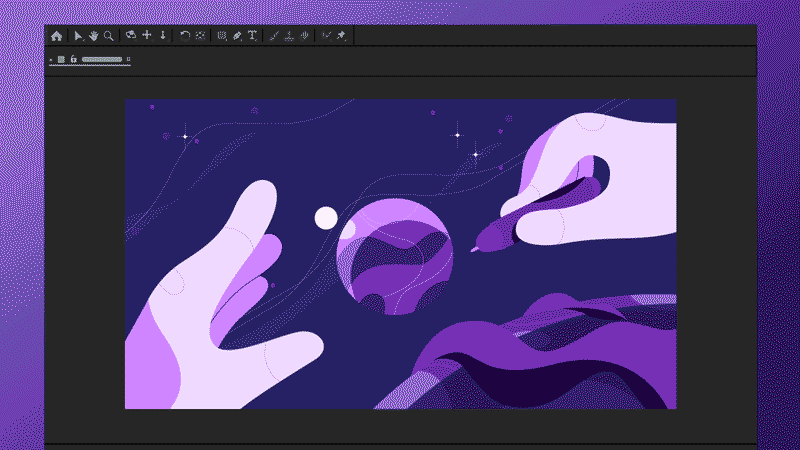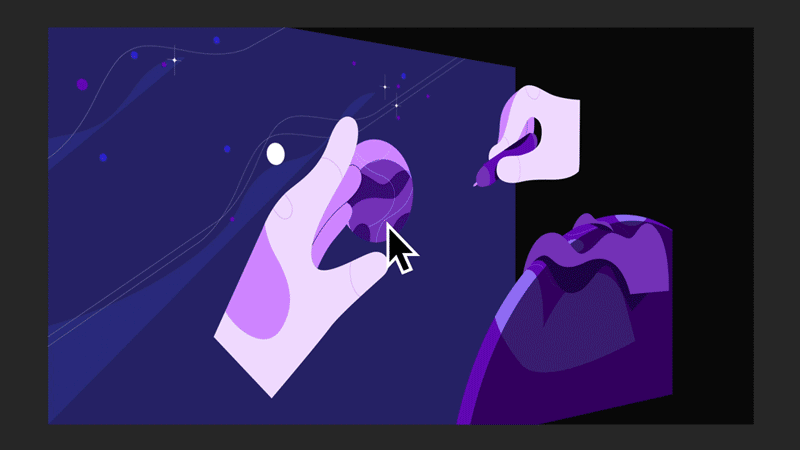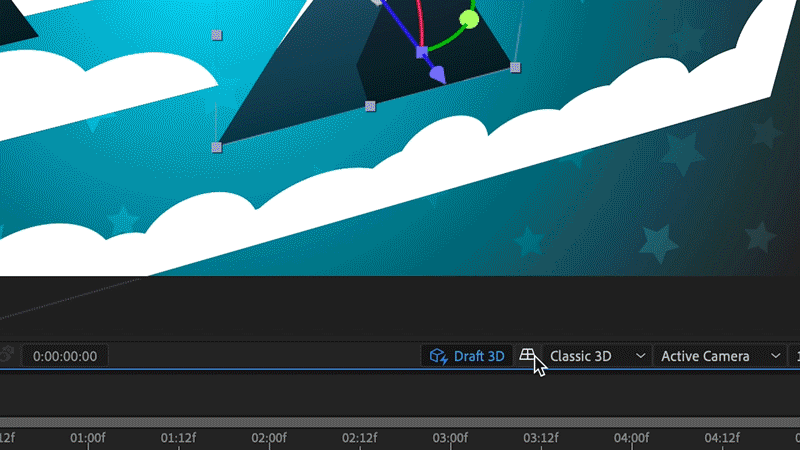The default is set to Orbit Around Cursor.
- After Effects User Guide
- Beta releases
- Getting started
- Workspaces
- Projects and compositions
- Importing footage
- Preparing and importing still images
- Importing from After Effects and Adobe Premiere Pro
- Importing and interpreting video and audio
- Preparing and importing 3D image files
- Importing and interpreting footage items
- Import SVG files
- Working with footage items
- Detect edit points using Scene Edit Detection
- XMP metadata
- Text and Graphics
- Text
- Motion Graphics
- Work with Motion Graphics templates in After Effects
- Use expressions to create drop-down lists in Motion Graphics templates
- Work with Essential Properties to create Motion Graphics templates
- Replace images and videos in Motion Graphics templates and Essential Properties
- Animate faster and easier using the Properties panel
- Drawing, Painting, and Paths
- Overview of shape layers, paths, and vector graphics
- Paint tools: Brush, Clone Stamp, and Eraser
- Taper shape strokes
- Shape attributes, paint operations, and path operations for shape layers
- Use Offset Paths shape effect to alter shapes
- Creating shapes
- Create masks
- Remove objects from your videos with the Content-Aware Fill panel
- Roto Brush and Refine Matte
- Create Nulls for Positional Properties and Paths
- Layers, Markers, and Camera
- Animation, Keyframes, Motion Tracking, and Keying
- Animation
- Keyframe
- Motion tracking
- Keying
- Transparency and Compositing
- Adjusting color
- Effects and Animation Presets
- Effects and animation presets overview
- Effect list
- Effect Manager
- Simulation effects
- Stylize effects
- Audio effects
- Distort effects
- Perspective effects
- Channel effects
- Generate effects
- Time effects
- Transition effects
- The Rolling Shutter Repair effect
- Blur and Sharpen effects
- 3D Channel effects
- Utility effects
- Matte effects
- Noise and Grain effects
- Detail-preserving Upscale effect
- Obsolete effects
- Cycore plugins
- Expressions and Automation
- Expressions
- Expression basics
- Understanding the expression language
- Using expression controls
- Syntax differences between the JavaScript and Legacy ExtendScript expression engines
- Editing expressions
- Expression errors
- Using the Expressions editor
- Use expressions to edit and access text properties
- Expression language reference
- Expression examples
- Automation
- Expressions
- Immersive video, VR, and 3D
- Construct VR environments in After Effects
- Apply immersive video effects
- Compositing tools for VR/360 videos
- Advanced 3D Renderer
- Import and add 3D models to your composition
- Import 3D models from Creative Cloud Libraries
- Create parametric meshes
- Image-Based Lighting
- Animated Environment Lights
- Enable lights to cast shadows
- Extract and animate lights and cameras from 3D models
- Tracking 3D camera movement
- Adjust Default Camera Settings for 3D compositions
- Cast and accept shadows
- Embedded 3D model animations
- Shadow Catcher
- 3D depth data extraction
- Modify materials properties of a 3D layer
- Apply Substance 3D materials
- Work in 3D Design Space
- 3D Transform Gizmos
- Single 3D Gizmo for multiple 3D layers
- Do more with 3D animation
- Preview changes to 3D designs real time with the Mercury 3D engine
- Add responsive design to your graphics
- Views and Previews
- Rendering and Exporting
- Basics of rendering and exporting
- H.264 Encoding in After Effects
- Export an After Effects project as an Adobe Premiere Pro project
- Converting movies
- Multi-frame rendering
- Automated rendering and network rendering
- Rendering and exporting still images and still-image sequences
- Using the GoPro CineForm codec in After Effects
- Working with other applications
- Collaboration: Frame.io, and Team Projects
- Memory, storage, performance
- Knowledge Base
Use the intuitive toolset to help you design and composite 3D content faster and more accurately, natively in After Effects.
Use the intuitive toolset to help you design and composite 3D content faster and more accurately, natively in After Effects. With all the 3D manipulation controls in one space, you don't have to constantly jump back and forth between 3D applications to get a single shot.
This design space has the following features:
With the camera tools, you can always move around the scene to see where things should be and how they can be moved, and then you can use the 3D Transform Gizmo to move them accordingly.
Explore working with 3D if you are new to After Effects or want to learn the basics.
Activate the 3D Design Space


- In the Timeline panel, enable the 3D switch for the layer(s) you want to manipulate in 3 dimensions.


This activates the 3D Design Space. The toolbar displays three camera controls - Orbit, Pan, and Dolly. Each of these controls contains multiple interaction points that you can use to manipulate objects in your scene in 3D space.
2. Click a 3D layer in the timeline to use the Transform Gizmo that enables you to rotate, scale, and position a layer with a single tool.


Create 3D Bins
When multiple 3D layers are placed together, you create 3D bins. They are groups of 3D layers that render together. When you place a 2D layer between two 3D layers, you create separate bins that render independently in 3D space.
Use the camera controls to quickly move around 3D space immediately after turning a 2D layer into a 3D layer.


Work with the different camera controls
Each of the camera controls has multiple interaction points that you can use to view and manipulate the objects in your scene. These controls have editable default settings. If coming from a different 3D application, you can change these defaults and save them for later use.






The default is set to Pan Under Cursor.
The default is set to Dolly Toward Cursor.
- 1/2/3 keys are used for switching camera tools or controls (3D preferences). Use Shift + 1/2/3 to cycle through each camera tool or control options.
- You can access the camera controls with the Alt in Windows and Opt in macOS.
Add a camera to your scene
After Effects allows you to view your layers in 3D space as soon as you start navigating. Once you are ready for a shot, add a camera to your scene by selecting View > Create Camera from 3D View. This creates a camera in your timeline based on your current perspective. You can further add multiple cameras to your scene based on various viewpoints.


You can customize how different cameras move by selecting the different modes from the three camera controls. For example, if you want your camera to orbit around a scene by default, change the settings accordingly.
Use hotkeys to switch between controls
You can switch and navigate between the different camera controls seamlessly using the hotkeys (keyboard keys) - 1, 2, and 3. You can edit the hotkey settings in the 3D Preference dialog.


You can also modify hotkeys in the Visual Keyboard Shortcut Editor.


Use the 3D Transform Gizmo to scale, position, and rotate 3D layers within a single tool. It offers you all the space manipulation tools in one. It works similarly to Dimension, where it allows you to transform each of the axis within the same tool. You can eliminate the need to go into separate properties like position, scale, and rotation to manipulate these.
- When you select multiple 3D layers at the same time, you can now manipulate them together using one unified 3D gizmo.
With After Effects 24.1 and above versions, you can import your 3D models directly into your project and drop them into your composite alongside other 2D and 3D layers. Learn more about how to import and add 3D models to your composition.
Extracting cameras and lights in After Effects can help you quickly recreate the scene you created using your 3D modeling application. You can extract cameras and lights from GLB and GLTF models in composition and animate them.
Get real time rendering of the changes you make to your 3D designs within After Effects. Backed with the faster and more efficient Advanced 3D engine, it gives you consistent, real-time previews throughout the creative process. In motion design, the speed of iterating and experimenting is critical for making creative choices. Use the 3D Draft preview to reduce the lag time in previewing, thus reducing the time between idea, action, and result. You can turn it on using the Draft 3D button in the composition toolbar.




The 3D Ground Plane keeps you oriented and gives you a sense of space while you navigate in Draft Preview mode, providing a visual cue to help position your cameras, lights, and 3D layers in relationship to one another.
When Draft 3D is enabled, a new Ground Plane button in the toolbar at the bottom of the Composition panel gets enabled by default. Use it to turn a ground plane on or off in the composition’s 3D space.


The Extended Viewer allows you to view the 3D content outside the composition frame boundaries. Switch back to the standard frame view when you need to view your composition’s final look.
To enable Extended Viewer, turn on the Draft 3D button in the Composition panel toolbar. The Extended Viewer button appears next to the Ground Plane button. You can also change the opacity of the extended view by selecting the Extended Viewer button, holding it down, and using the slider to change the value.
When Extended Viewer is enabled, effects applied to collapsed precomps may cause the layer to get cut off at the composition boundary.